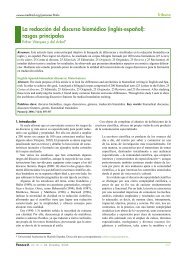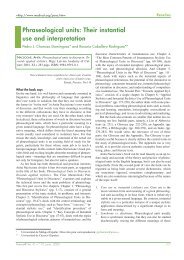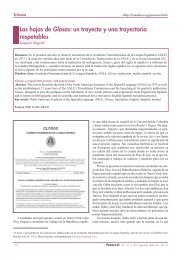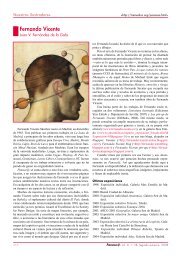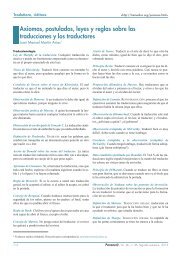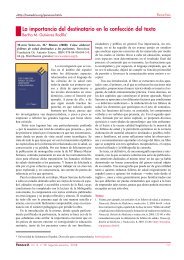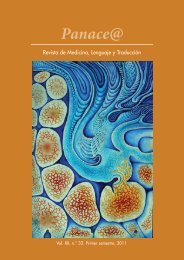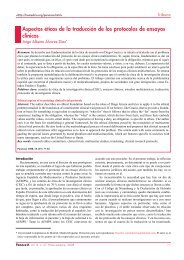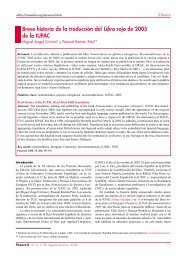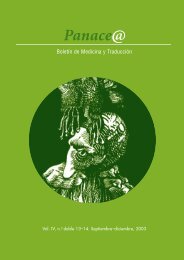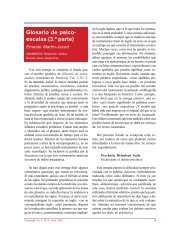Panace@ 26. Diciembre del 2007 - Tremédica
Panace@ 26. Diciembre del 2007 - Tremédica
Panace@ 26. Diciembre del 2007 - Tremédica
You also want an ePaper? Increase the reach of your titles
YUMPU automatically turns print PDFs into web optimized ePapers that Google loves.
Tribuna<br />
<br />
In the above example the oncologist, after patient’s initiation<br />
(I had vomiting), asked about the timing and content of<br />
the event and then allowed her and her partner to develop their<br />
story. The result is a co-narration where both participants contribute<br />
to the topic of food poisoning. In this section I will not<br />
appraise the joint construction of this story as this point will be<br />
discussed further on in this manuscript in section 5.2. What is<br />
of interest here is to observe how the patient’s self-identity defies<br />
the ‘predictable’ medical script of the medical event.<br />
This segment shows the voice of Social Communicator in<br />
full display by telling us about what the patient was doing on<br />
Saturday night (wedding), who accompanied her (partner),<br />
what she ate on that night (marinated raw shellfish), how<br />
she felt about herself (silly) and the effect she had with the<br />
consumption of shellfish (food poisoning). All these elements<br />
provide us with a picture of a joyful young woman enjoying<br />
the pleasure of nice food in good company.<br />
Following Labov’s narrative analysis it is possible to interpret<br />
this segment as having an a) Abstract: what was this about?<br />
–food poisoning; b) Orientation: who, when, what, where? –his<br />
patient, the day before, at a wedding; c) Complicating action:<br />
then what happened? –the patient was attracted to marinated raw<br />
shellfish and ate it; d) Evaluation: so what? – the patient vomited;<br />
e) Result: what finally happened? – the patient became sick.<br />
At the structural level of analysis the segment shows the main<br />
topic of this personal story (food poisoning) and suspense (‘I<br />
saw that there were some mussels with marinated raw shellfish<br />
and I served myself’). Patients who have gone through a number<br />
of chemotherapy courses following a bone marrow transplant,<br />
as this patient had, have a depressed immune system which<br />
is unable to cope efficiently with infective micro-organisms<br />
(e.g. bacteria) that could potentially be found in raw shellfish.<br />
This segment also shows a resolution ( ‘I ended up very<br />
sick’), doctor’s evaluation (‘Not yet we’ll need to wait some<br />
time before that’) and patient’s acknowledgement of responsibility<br />
in the event (‘Yes I know but sometimes I just forget<br />
that’s the problem I forget that I’ve had a transplant’)<br />
The display of this story is very powerful as the oncologist was<br />
able to get vital information that he would not have obtained<br />
had he stayed within the medical ‘voice’ and restricted the<br />
unfolding of the story.<br />
5.2. Co-narration in the medical visit<br />
We observe that relatives participated in 25/36 joint-production<br />
storytelling events (patient-relative-doctor and relative-doctor)<br />
in contrast with patients who elaborated less than<br />
one third 11/36 of the stories in a dyad composition (patientdoctor)<br />
(See Table 1).<br />
• 25/36 storytellings are co-narrated in group dyad composition<br />
(patient-relative-doctor and relative doctor).<br />
• 11/36 of storytelling in a dyad composition<br />
(patient-doctor).<br />
• The difference is statistically significant (X2 1 = 5.44, P<br />
< 0.03), indicating a preference for increased co-narration<br />
involving the accompanying relative.<br />
Table 1. Results and Interpretation of co-narration<br />
Note that an accompanying person was present in all but<br />
one consultation. Looking more closely into the sex composition<br />
of participants we observe that every patient was accompanied<br />
by a female relative except for one young couple<br />
and one female patient in her thirties who went to the check<br />
up on her own.<br />
Doctor voice (examen físico)<br />
FR: Sabe que ha estado más animadito que la primera eh::=<br />
MD: =Porque estaba mejor antes de empezar el tratamiento<br />
FR: Ah::<br />
MP: La primera me tuvo como botado con el sentido de<br />
que:<br />
FR: Y al pasar esta vez de la segunda de la segunda, el segundo<br />
ciclo de ahora ha estado más animado que los días <strong>del</strong><br />
Año Nuevo y días de Navidad anduvo como cinco o seis días<br />
así bien polli::to estaba bien acostadi::to<br />
MP: O sea que me levantaba y me daba sueño más luego<br />
entonces que hacía me levantaba un rato y eh de repente antes<br />
de ir a almorzar o después <strong>del</strong> almuerzo ahí me acostaba<br />
un rato y se me quitaba yo le decía si lo que tengo es igual<br />
[que si]<br />
MD: [ya]<br />
MP: hubiese jugado un partido de fútbol le decía yo estoy<br />
amolado pero con que duerma un rato se me quita<br />
FR: ((@@@)) fíjese ahora que tiene más energía que yo<br />
((@@@)<br />
MD: Ya mi pregunta ahora es la siguiente<br />
(Shift to the Doctor voice –tests to be carried out)<br />
Doctor voice (physical examination)<br />
FR: You know he has been feeling in better spirit (than the<br />
first course) ehm=<br />
MD: =Because he was in better shape when he started this<br />
(chemotherapy) course<br />
FR: Ah::<br />
MP: During the first (course) I felt run down I mean:<br />
FR: And this one this second, second, second course now<br />
he has been feeling in much better spirit than those days on<br />
New Year’s Day and Christmas Day when he felt run down<br />
for five or six days he used to lay down most of the time<br />
MP: I mean I’d come out of bed and feel sleepy soon after<br />
so what I used to do was to come out of bed for a while and<br />
ehm sometimes before or after lunch I’d lie down for a while<br />
and I’d feel better I used to say to her (his wife) that I felt as<br />
[if I]<br />
MD: [yeah]<br />
MP: had played a soccer match. I’d tell her<br />
I’m feeling run down but if I sleep for a while I feel better<br />
FR: ((@@@)) Look at him he now he has more energy than<br />
me ((@@@))<br />
MD: Now I’d like to ask you the following question<br />
(Shift to the Doctor voice –tests to be carried out)<br />
Example 3 (co-narration of Health-related storytelling: I’m feeling<br />
better now!).<br />
MD: medical doctor, MP: male patient, FR: female relative.<br />
234 <strong>Panace@</strong>. Vol. IX, n .o <strong>26.</strong> Segundo semestre, <strong>2007</strong>



